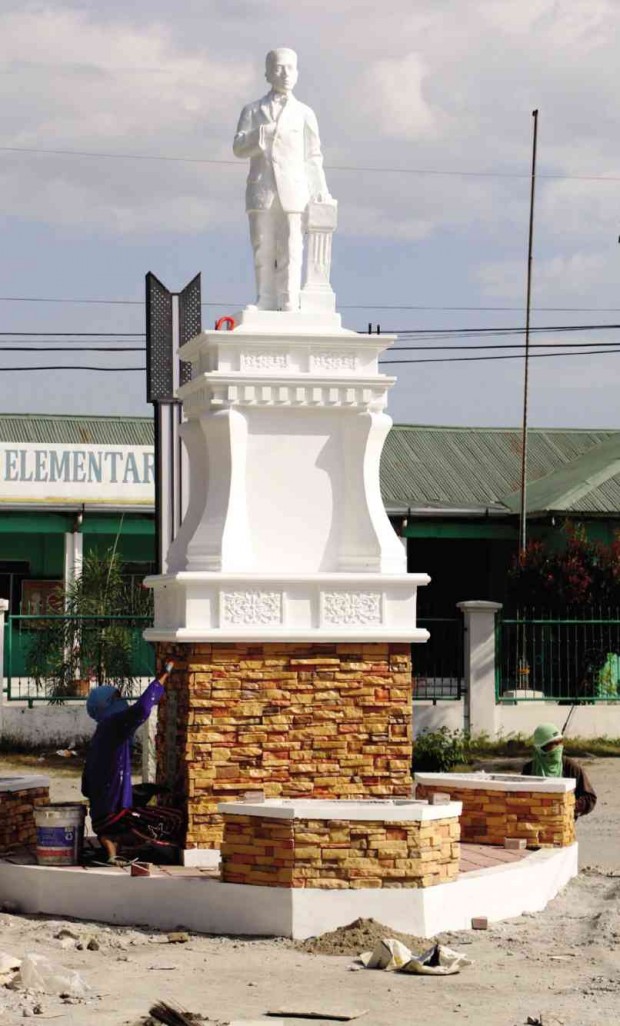Tour brings back Bacolor past buried by Pinatubo eruptions, lahar

IN 1924, grateful citizens of Bacolor in Pampanga built a monument in honor of their leader-writer Felix Napao Galura. They raised his monument twice from lahar. E. I. REYMOND T. OREJAS
It was past 8 a.m. on Feb. 22 when around 100 people, mostly in their 20s, gathered at Don Honorio Ventura Technological State University (DHVTSU), said to be Asia’s oldest vocational school, in Bacolor town, Pampanga.
An actor entered and introduced himself as Apung Dodi (Old Man Dodi), who was popular for his coffeehouse at the old public market before the 1991 eruptions of Mt. Pinatubo.
He talked with four other performers, one of whom recalled Baculud, his term of endearment for the old town before it was almost erased from the map by the eruptions and lahar rampages.
Then they led the growing crowd to a nearby monument of Juan Crisostomo “Crissot” Soto at an intersection of a new road built on 10 meters or more of lahar.
Dodi recited Soto’s “Baculud,” a poem on the burning of the town center on June 4, 1898 at the height of the 1896 Revolution against Spain. Ninety seven years ago, he said, Soto likened Bacolor to a “fenix nung matua na ya/Subli yang anac qng abu na ya (the phoenix is reborn, rising from its ashes).”
With the crowd still trailing by foot, the troupe toured six more cultural and historical sites left by the disaster.
There the actors read excerpts from Soto’s “Anac ning Catipunan,” “Lidia,” “Miss Phatuphats”; Fr. Anselmo Jorge Fajardo’s “Don Gonzalo de Cordoba”; Felix Napao Galura’s “Ing Mora”; and Mariano Proceso Pabalan’s “Ing Managpe”—iterary works produced when Bacolor was the “Athens of Pampanga” at the turn of the 20th century. “Ing Managpe” was the country’s first zarzuela in the vernacular.
This was Bacolor LiteraTour 2016.
Mix of history, literature
DHVTSU piloted this mix of literature, history, travelogue and performance art in honor of Galura whose 150th birth anniversary was held on Feb. 21.
The Galura monument, built in 1924 by a group of Bacolor residents called Aguman 33, was raised for the second time from lahar and relocated to its original site between the town hall and Bacolor Elementary School.
It retained the declaration that Galura was a “Caluguran nang Anac ning Baculud (Beloved Son of Bacolor).”
LiteraTour is one of DHVTSU’s way of helping Bacolor rise from disaster that struck Central Luzon 25 years ago, according to Francis Musni, curator of DHVTSU Heritage Museum.
Bacolor was a former Philippine and Pampanga capital.
Enrique Baking, DHVTSU president, said the university continues to be “committed in keeping the spark of love for our language and culture as Capampañgan, alive and burning.”
Musni said Galura was a poet, translator (Dr. Jose Rizal’s “Noli Me Tangere”), playwright (“Ing Mora”), editor, religious writer (prayers and “Pasyon”), grammarian (“Gramatica Castellana” and “Sanayan A Malagwang Pipagaralan King Amanung Kastila”) and journalist. He cowrote with Juan Crisostomo Soto the zarzuela “Ing Singsing a Bacal” (“The Ring of Steel”).
Originally a member of the Spanish civilian auxiliary force, Galura shifted allegiance after the arrest of Pedro Liongson and joined the revolution against Spain as a lieutenant colonel under Gen. Tomas Mascardo.
He was presidente of Bacolor from 1909 to 1918. He died on July 21, 1919 at 53, earning an elegy from Rizal’s cousin, Don Monico Mercado.
LiteraTour intends to produce a module as a guide for other towns and cities in designing their own tours.
Nestor Galura, chair of DHVTSU Center for Capampangan Culture and the Arts, said an anthology of the writings of Felix Napao Galura would be published this year to make these available to teachers, scholars and the youth. Tonette Orejas